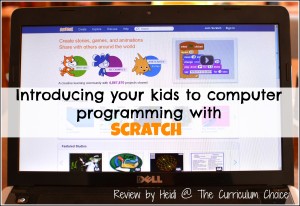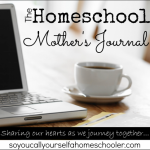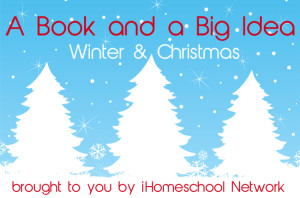 Hi, I'm Heidi and I homeschool my two sweet kids. I want them to know that learning is an exciting lifelong adventure! We love great books, unit studies, notebooking, lapbooking, and hands-on learning.
Hi, I'm Heidi and I homeschool my two sweet kids. I want them to know that learning is an exciting lifelong adventure! We love great books, unit studies, notebooking, lapbooking, and hands-on learning.Recent Homeschool Reviews
You know I write reviews for The Curriculum Choice, right? I forget to pop in here and update when I have a new review up over there. My most recent review is about one of the hits for our family this year, and I wanted to let you know about it so you can check it out. Have you ever heard of Scratch, a terrific and FREE way to introduce your children to computer programming?
While I’m at it, here are a few others I’ve done this year:
- Snap Circuits is a great tool for hands-on education about electricity
- New to us this year are Latin curricula from Classical Academic Press, and I’ve been extremely pleased with the materials for my eight- and eleven-year-old: Song School Latin and Latin For Children.
- A few great books I’ve used and reviewed this year are The Kids’ Book of Weather Forecasting (education and inspiration for junior meteorologists), The Story of the Orchestra (learn about composers and the instruments of the orchestra) and Storybook Art (art projects inspired by picture books).
By the way, while you’re over at The Curriculum Choice make sure you subscribe! It is one of my favorite blogs to read (and was even before I was one of the contributors). I adore my fellow authors at TCC: sweet women like Trisha of Hodgepodge, Barb of Harmony Fine Arts, and Cindy of Our Journey Westward. Reading their review posts is like sitting down to coffee with an experienced homeschool mom and having her share a favorite product that she uses in her home.
Care to keep up to date on the products we’ve tried and resources we’ve fallen in love with?
- Check out my Reviews and Resources page on the blog, where I keep links to all my reviews published here and on The Curriculum Choice as well as the extra special resources that have helped me in my homeschooling endeavors.
- You can also find those and all my reviews in one place on My Homeschool Reviews Pinterest Board.
How I Teach Homeschool Fine Arts
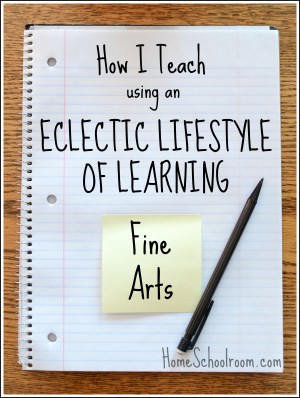
This is the final installment in the “How I Teach” series, where I’ve been sharing how I approach each subject area. It’s time for the finishing touches: fine arts.
What do I try to cover in fine arts?
This is where I bring in the beauty, all that is lovely in classical music and art, theater and dance. I’m interested in two things: appreciation of beauty through experience and education, and also opportunities to produce beauty.
Why are fine arts necessary?
Why bother with fine arts? Aren’t they just frosting? Well, one of my favorite homeschool authors says it better than I can:
Great paintings, like great music, are part of our common culture. They are part of the core that educated people enjoy and share and through which we all gain deeper understanding of human possibilities in this world…What we want is for the children to use their minds in a kind of thinking that they don’t experience while practicing subtraction or learning the past tense of verbs…Study more than the tyrants and wars of the past. Enjoy the best of civilization. Enjoy music and art.” Ruth Beechick in You Can Teach Your Child Successfully
How Do I Teach Homeschool Fine Arts?
I was initially nervous trying to cover fine arts because of my limited knowledge, but I’ve found great joy in learning alongside my children using simple techniques and a myriad of available resources.
*This post contains affiliate links to products I use and enjoy in our home.
- Both my children take private music lessons that include music theory. This one requires the highest financial sacrifice and time commitment, but also has the largest life-long benefit. My children both have developed a love for their instrument and enjoy playing for others, both informally in our home and at recitals and church.
- My eleven-year-old daughter recently joined the adult choir at our church, which is not only providing a lot of music educations, but a lasting relationship with the choir director, the delightful members of the choir, and the lovely songs they sing.
- This is our second year utilizing Harmony Fine Arts, an art and music appreciation curriculum created by Barb, a homeschool mom who just graduated her third child. Her materials have been instrumental in our fine arts education: she provides a fabulous framework to help me know what to introduce, leads me to wonderful resources (like The Story of the Orchestra), and provides instruction in methods that are simple and enriching, like picture study. And here’s a great tip I learned from her: discounted calendars are an inexpensive way to obtain large full-color prints by famous artists. I just picked up a Monet calendar for $3 at an art museum!
- Another homeschool-mom-created curriculum that I love using is SQUILT by Mary from Homegrown Learners. The Super Quiet Uninterrupted Listening Technique helps your children form a personal relationship with great classical music, and Mary provides the background information to allow you to have educated discussions with your children about what they hear.
- Two other easy to use resources are Maestro Classics CDs (I bought Peter and the Wolf for Christmas), and listening to Classics for Kids, an excellent radio show (you can listen online or as a podcast) that teaches children about composers and pieces of music.
- We go to experience fine arts when possible. We’ve enjoyed wonderful opportunities: Shakespeare’s Twelfth Night, a production of The Nutcracker with full orchestra, the musical Annie, an on-stage radio theater presentation of A Christmas Carol, art museums, etc. This can also become expensive so I watch for discounted tickets. I also use quality DVD recordings, like we did for CATS, to bring the productions to us.
- To produce art I use resources like Storybook Art, keep supplies on hand and allow my children free use of them, and use ideas from my Art and Artist Study Pinterest board for learning about great artists and producing our own art. We also enjoy participating in Sketch Tuesday at Harmony Fine Arts. Email your sketches on that week’s theme, and then enjoy a slideshow of everyone’s drawings.
- We’ve begun studying hymns using the book Then Sings my Soul: 150 of the World’s Greatest Hymn Stories. It’s simple: I read the story of the hymn from the book and find a YouTube video with the words displayed on the screen. We listen regularly and try to sing along until we’ve learned it.
I hope this in-depth look into how I teach each of the subjects has been helpful. I love learning alongside my children and finding the methods that work for all of us to enjoy the journey of education.
The “How I Teach” Series:
- Our Family and Philosophy
- How I Teach Language Arts
- How I Teach Math
- How I Teach Science
- How I Teach History
- How I Teach Fine Arts
How I Teach History Using an Eclectic Lifestyle of Learning
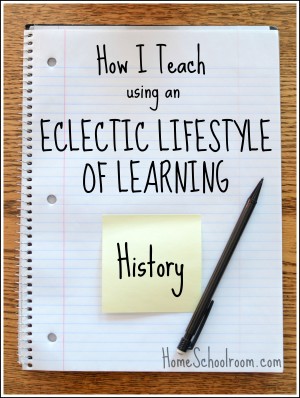
Remember when I said that before I started homeschooling I was excited to share my love of science with my children? Well…I didn’t have the same enthusiasm for history. It was never my favorite subject in school–it seemed just lists of dates and names that I could not remember.
The History of Our Homeschool History Studies
Our first attempt at history was studying the Revolutionary War using a free Homeschool Share unit. We read wonderful stories of the people and events, watched dramatizations of the action, and made period food and crafts. No one had ever told me history was so interesting!
We continued immersing ourselves in historical time periods over the next two years. It was still fascinating, but I found the need to simplify this year. I was planning too much, creating an overwhelming workload for myself and listing more work than we could ever complete. It was taking away the joy of our learning, and kept us from moving on and learning new information because I was waiting to complete all the things I had planned!
So this year, it’s a less-is-more approach. I’ve made great strides in taming my tendency to plan too much. It’s not to say we’re less interested or even that we’re learning less, but I’m planning less, we’re focused more on reading and narrating, with hands-on activities directed by my children with less work from me.
Not only is this more relaxing and joyful for me, but we’re moving through the periods at a reasonable speed, staying in tune with prime interest and learning and allowing them to see the connections between time periods!
Homeschooling History Take Two: Relaxed, Eclectic
I’m using Story of the World as our spine along with the corresponding activity guide. So far we haven’t used many of the activity suggestions, but I use the book lists for extra reading and usually one of the maps for each civilization. Using a spine text has simplified my planning. The other must-have resource for me is All Through The Ages, a guide full of recommended living books to use in studying history.
Here’s our simple plan for history studies:
- FOCUS ON READING:
- We read a chapter in Story of the World for a basic understanding of events.
- We read living literature to give us a deeper understanding. And read…and read some more!
- We watch videos for fun and educational value. This can be anything from the hilarious Horrible Histories to documentaries on Netflix.
- NARRATE:
- My children narrate what they have gleaned from our reading. (More details on our narration in just a minute.)
- If time and ideas permit WE MAKE AND DO. (I’ll talk more about how and what…just keep reading!)
A Note on Narrating
Narrating is simply retelling what the child has learned in their own words. It’s a simple yet powerful Charlotte Mason technique. The difference this year is how often I’m having my children narrate and how I’ve simplified the implementation. We’re narrating nearly all of our history reading, so it is happening at least a couple times a week. Recording them is simple: my daughter writes or types her own (we edit together when she’s done) and my son draws a picture then gives me an oral narration while I act as his scribe. No searching for themed notebook pages or fussy to cut minibooks. Just plain printer or notebook paper, filled with ideas bursting from their minds!
Our Hands-On History Learning
Our simplified plan doesn’t mean no hands-on learning opportunities. I’m just more careful about which ones and how much it requires of me. I’m not combing the internet and trying to orchestrate every hands-on learning opportunity I see. I keep a tight reign on what activities I plan, keeping in mind what can be learned or reinforced by it, and how much time and effort it requires, both from me and my children.
What has worked well so far is a two pronged approach that facilitates hands-on learning without bringing back my overworked feelings:
- For each civilization one of the books I choose is one with activities: games, crafts, recipes, etc. For instance, we used the book Ancient Egyptians and Their Neighbors when studying Ancient Egypt. I can choose hands-on ideas, or my daughter (who loves making things) can choose independent projects.
- I allow my children’s ideas, and what intrigues them from the information, be my guide. For example, it is common for my children to role-play our history studies. One day they decided, on their own, to act out one of the Greek myths. Now I’m happy to help them make simple Greek costumes from a white sheet (from the book Spend the Day in Ancient Greece). I am confident a little effort on my part will enhance their reenacting, and this will in turn help them remember the stories even better.
That’s the how-to of our history studies. There’s one more installment in the “How I Teach” series. Join me next time when I put on the finishing touches: fine arts!
The “How I Teach” Series:
How I Teach Science Using an Eclectic Lifestyle of Learning
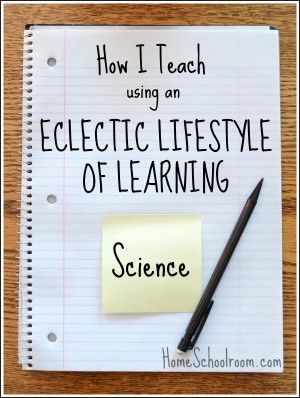
When I decided to homeschool I was excited to share my love of science with my kids. Like other subjects, I tackle it in lots of ways. We used a formal curriculum in the past, but it felt restrictive. That’s not to say I won’t use a formal curriculum again, especially in the later years, but this year we’re on our own.
My overall theory of science education is based in part on Ruth Beechick’s writings. I try to remove myself from the role of “answer giver,” which tends to stifle their curiosity. How do I make sure my kids are learning about the world of science? Easy: it’s all around us and they’re always asking questions!
Let me share specifics about nature study, since that’s a large component of our science studies, and then how we work in other fields of science quite naturally.
Nature Study
Nature study is a terrific area for homeschool science exploration because the specimens you need are right outside your door! It’s a classic part of a Charlotte Mason education and can start your children on a lifelong love of spending time in and observing nature.
Our nature studies are a combination of being open to opportunities and intentional about introducing topics.
Sometimes nature study finds you. This requires providing time in nature and showing my kids I’m willing to put my plans on hold to pursue what they find interesting. In other words, I have to be ready to stop and smell the roses…then look up why flowers have a scent!
When nature topics don’t naturally find us, being intentional about introducing topics can increase my children’s interest in nature. Regularly incorporating nature study is easier with help from Barb at The Handbook of Nature Study blog. She provides ideas, printables, helpful links, and a sense of community in studying nature. Follow her blog and before long you’ll have a nature table and be heading out looking for lichen or drawing dandelions.
Our study of birds is a good example of how studying nature can fosters more interest. We began learning the names of our backyard birds, then did a bird unit study. Now each February we participate in the Great Backyard Bird Count, we continue to learn about new birds we see, find topics we want to research further (like murmuration), and my kids consider themselves birdwatchers.
Nature study is a valued and diverse part of our science education. Here are some other things we’ve done this year:
- Studies the moon and its phases
- Took a trip with Diver Ed for an up-close look at ocean life
- Learned about Squirrels (inspired by our frequent backyard visitor)
- Visited a bird sanctuary for a presentation on owls, then of course we dissected owl pellets (best science project ever!)
- Right now we’re studying weather predicting using the book The Kids’ Book of Weather Forecasting (One of my educational Christmas gifts to my children.)
Other Science Learning
Other than nature study what do we do? Again, I focus on being open and intentional!
Lots of science topics come up naturally. Just think about these questions from my children: Why does my skin form a scab? Why do racing bikes have thin tires? Why does the salt keep ice off the roads? There you have biology, physics, and chemistry! I try to find answers to their natural questions.
A note to other moms like me who plan TOO much: it also doesn’t require a full blown unit study when your child asks how a compass works. Grab a book, watch some YouTube videos and make a start!
Other than pursuing interest-led topics, I work to be intentional about introducing scientific information and skills. My goal is to expose them to the fascinating science all around them and show them how to learn more! Books, videos, and hands-on learning round out our science education.
Science Books
We books we own or borrow from the library for reading aloud, as a reference, or just to leave sitting around to encourage looking through. The books can be filled with pictures, in-depth information, and sometimes even hands-on learning ideas. Right now I’m considering adding The Story of Science (here is a review by a fellow Curriculum Choice author) so we can read about science discoveries that coordinate with our history studies.
Science Videos
We often watch science videos during our “Learning Lunch,” or with my husband on the weekends. Here are some of our favorites:
- Beakman: This is a humorous general science show available on Netflix right now. There are even ideas for projects: my kids still remember the camera obscura we built from a cardboard box!
- Bill Nye: My kids don’t like him quite as much as Beakman, but it is a good show where each episode centers around a theme.
- Science Friday: In these short videos on YouTube they speak to experts in a particular field of science, so it’s neat to see the variety.
- Magic School Bus: These are wonderful for younger kids, sadly we’re beginning to outgrow them!
- How It’s Made from the Science Channel is also on Netflix. It’s fun to see what’s behind everyday items from guitars to cars.
- Mythbusters: There can be adult topics so I make sure to watch with my children, but I find it loaded with good information and a demonstration of the scientific technique. My son will often experiment on his own after watching the show.
Science Equipment and Supplies
I aim to hone their ability to collect, observe and experiment by having scientific tools and supplies in our home. They provide a lot of opportunities for hands-on learning. We add to our materials over time, keep our eye out for used items, and use them as gift ideas!
These are favorites in our home that get regular use:
- Magnifiers and microscopes: from a jeweler’s loupe and pocket microscope (both around $5) to a full size microscope and stereo microscope (purchased used) we enjoy getting an up close look at little things, like snowflakes.
- Snap Circuits: a super hands-on electrical circuit learning toy.
- Models and specimens: a mini skeleton (“Mr. Bones”) and human body with organs (“Mr. Gooey”), insects in acrylic, and our own collection of natural items
- Science kits: These help with specific interests. We’ve enjoyed dissecting owl pellets and testing for bacteria this year. We’re looking forward to working through some new kits my son received for Christmas.
So that’s the not-so-succinct summary of our science learning. Join me next time for how I teach history!
The “How I Teach” Series:
How I Teach Math Using an Eclectic Lifestyle of Learning
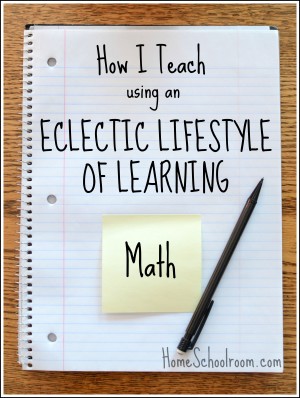
It’s time to talk numbers in the “How I Teach” series. Don’t worry, this shouldn’t take me quite as long as yesterday’s post on how I teach language arts! My approach to teaching homeschool math is quite simple, but still eclectic. The primary instruction comes in the form of a formal curriculum, but I round it out with what most people call “living math.”
Our Math Curriculum: Teaching Textbooks
We switched to Teaching Textbooks in our second year, and though no curriculum is perfect I’m very pleased. My eleven year old daughter works independently on Math 6, but I have her show me any questions she got wrong so I can spot problem areas. Not only does Teaching Textbooks save me having to grade math problems, but it gives my daughter immediate feedback on incorrect answers. My eight year old son is working through Math 3 (the earliest level available). Because his understanding of mathematical concepts is ahead of his reading skills I find it more efficient to sit and work through the lessons with him. With him I also usually break it up and do the lecture and practice one day, the problems the next.
Memorize Math Facts
I understand the importance of having the basic math facts solidly memorized. I mean, who can learn higher level operations if they have to think about what the answer to 6+7 or 3×8 is? I also, however, detest working with my children with flashcards. Xtramath.org is a free website providing timed work on math facts. It frees me up to work on other things, able to rest comfortably that when my children receive a mastery score from Xtramath they will have their facts firmly in memory.
Living Math
So what is living math? I would describe it as working with numbers in connection with real life. I’ll list some of the general ways we play with numbers, and you can visit my Homeschool Math Pinterest board for specific ideas.
- Life of Fred: My kids love the hilarious story component of the Fred books. We’ve used some of the Elementary books and my daughter is working through Life Of Fred Fractions. Though designed as a curriculum we use them as a supplement.
- Bedtime Math: This is a super easy way to incorporate a little math problem solving. The theory is that we read stories to kids before bed, why not work math problems, too? Every day on the Bedtime Math website you’ll find a story with related math questions at three different age levels. I usually do the problems with my kids during our “learning lunch.”
- Hands-On Math: We might play store or practice Tally Marks. Whatever the concept we try to work with it with our hands. And it doesn’t have to be a game or something orchestrated just to teach the concept: try making things! There are so many options here: baking, sewing, building with wood… It’s real life math manipulatives, and they’re motivated by the end product.
- Reading about Math: That’s right, my love affair with learning through books continues with math! You’ll find great titles to get you started from Cindy West of Our Journey Westward for elementary and even middle school students!
That’s my homeschool math instruction in a nutshell. Come back tomorrow for the scoop on SCIENCE!
The “How I Teach” Series:
How I Teach Language Arts Using an Eclectic Lifestyle of Learning
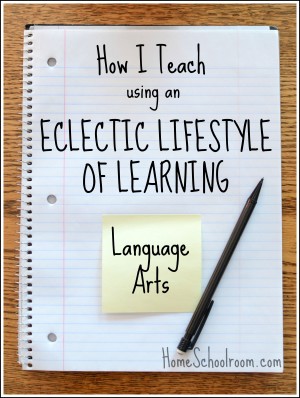
Yesterday I introduced our family and philosophy, now it’s time to move into the nitty gritty: how do we DO this thing called homeschooling? Today the topic is language arts.
Language arts: the subjects (as reading, spelling, literature, and composition) that aim at developing the student’s comprehension and capacity for use of written and oral language.” Miriam-Webster.
Whatever path my children choose in life, the ability to communicate effectively through written and spoken language is fundamental. Grab a cup of coffee, because with such a broad–and important–area of education I’m bound to get a bit wordy!
Before I start, let me tell you the books with the most impact on my teaching style in language arts. Though I do own the original Charlotte Mason homeschooling series (which you can read free here), A Charlotte Mason Companion by Karen Andreola has helped me implement CM philosophy. Two books by Ruth Beechick have also had a great influence on my homeschool instruction: The Three R’s and You Can Teach Your Child Successfully. (I reviewed both of them on The Curriculum Choice.)
Reading and Literature
My eleven-year-old daughter was already a tremendous reader when I began homeschooling her in third grade. We’ve simply continued lots of independent reading and reading aloud. I am happy with how we’ve arranged what she is reading. She must read one chapter daily in a book from a literature list. I created the list with more books than necessary so she has some choice. She can choose free reading books from Honey for a Child’s Heart and Read for the Heart. That way I feel confident the content will feed her soul, and it’s far better than looking on the library shelves and choosing by cover.
My eight-year-old son did not take to reading as quickly as my daughter, but is coming along very nicely. He finished Funnix last year, so this year our plan is simple: read. He reads to me every day as we cuddle on the couch, and I still read aloud a lot to both my children. If we need a little backup in any area, it’s Ruth Beechick’s The Three R’s to the rescue. Her methods are practical and natural.
One thing that I’ve already mentioned twice but I want to stress again: reading aloud. Not only is it a great source of enjoyment, but I believe the patterns of language and wonderful vocabulary are soaked in through listening to literature read aloud, especially books that would be far above their reading level.
Lastly, we meet with one other homeschool family for a very informal book club. All of us read the same book and record our thoughts in a journal, then we get together to discuss the book.
Spelling & Grammar
My plan in spelling and grammar is based on ideas from Charlotte Mason and Ruth Beechick. I don’t use a formal curriculum, but prefer customized instruction by working on issues within their writing. My son is only eight so his writing is limited (I still act as a scribe for his narrations and stories). For my daughter, if I see a word frequently misspelled we’ll add it to a list and work on it for a while. Grammar is also taught within writing. I have several grammar books (I reviewed Nitty Gritty Grammar) we use for reference.
Composition
Though I love the natural methods of Mason and Beechick, I’m also fine with using a formal curriculum at times. Last year my daughter and I worked through WriteShop Junior D and she gained some great skills to add to her writing toolbox. We spent summer and fall without a curriculum, then this winter we’ll try out WriteShop I.
Outside of a formal writing curriculum a lot of writing–letters to friends, notebooking school subjects, stories, a family newsletter, and ideas from my Language Arts Pinterest board. Other than the letters to friends, we edit these together and use them as a quick lesson on anything from misplaced modifiers to word choice.
General Language Arts Skills
Copywork, Dictation and Narration
These natural and powerful techniques are classic Charlotte Mason. I am convinced that regular use is a great tool for expanding skills in both written and spoken language. Ruth Beechick’s books helped with the step by step of using these techniques at each of my children’s specific levels. Though copywork and dictation don’t happen as often as I’d like, narration is a very regular part of our homeschool, especially in history. My daughter writes or types her narrations and we edit them together. I act as a scribe for my son. He can practice organizing his thoughts and use his vast vocabulary without knowing how to spell the words.
Memorizing Poetry
I always loved the idea of memorizing poetry, but hadn’t made an attempt to implement it. Then I listened to a talk by Andrew Pudewa called Nurturing Competent Communicators and realized it wasn’t just a fancy skill to impress the grandparents, but was an opportunity to build a model in their minds of the best use of language. This isn’t a hard and fast subject for us: we find a poem we like, I copy it and post it where we’ll see it frequently. We recite it often and play around with quizzing each other on what comes next. The kids learn them way faster than I do! By the way, I don’t make a rule that they have to be serious classics: Sister for Sale by Shel Silverstein is a favorite.
Latin
I’m putting this in language arts because of the effect it has on the child’s language development with grammar structure and vocabulary. This is where the classical philosophy enters my eclectic mix. We enjoy using Classical Academic Press materials: Latin for Children for my daughter and Song School Latin for my son. With LFC we use it almost exactly as directed, other than taking longer than one week for each chapter–there is a lot of material there! With SSL I do all work orally with my son and don’t require the written work that is available in the student workbook.
Nightly Notes
One area of writing practice that deserves special mention is how my children and I write notes back and forth to each other in a spiral notebook. They write their message to me after I tuck them into bed. Hint: if you have a reluctant writer, the option of staying up a little later to compose a note is a great tactic to encourage writing. I write back sometime during the day. Not only is it fun writing practice where I can easily model correct techniques, but it’s a relationship builder as well.
That’s the lowdown on my language arts teaching. Come back tomorrow for the scoop on how I teach math. The good news is I don’t think it will be half as long as this post!
The “How I Teach” Series:
- Our Family and Philosophy
- How I Teach Language Arts (You just read that one!)
- How I Teach Math
- How I Teach Science
- How I Teach History
- How I Teach Fine Arts
How I Teach Using an Eclectic Lifestyle of Learning
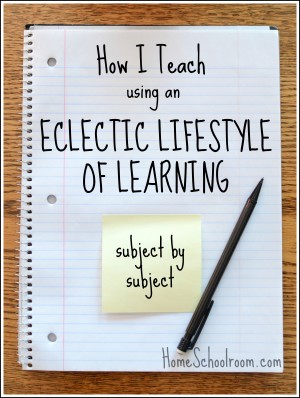
I love how homeschooling allows families with different homeschool philosophies, teaching styles, numbers and ages of kids, to tackle educating our children in the way that suits them. Care to see how it works around here? Then stay tuned as I plan to write about how I homeschool, subject by subject.
As an introduction today let me tell you a little about our family and philosophy:
Student #1: My Eight-Year-Old Son
A near carbon copy of his daddy, this little boy is like a lot of little boys: he loves science and math more than reading and writing. Working to read might not be his favorite thing, but he loves listening to me read aloud. He’s very imaginative and quite creative when problem solving. He can get very focused and lost in his work–when it’s of interest to him. He’d much rather use his brainpower to build things than worry about making sure he has his shirt on frontwards. His particular interests are military equipment and history, animals, learning to play guitar, Legos, robots and other technology.
Student #2: My Eleven-Year-Old Daughter
My girl is a bit of a mini-me. She has always loved reading and writing and thinks science is pretty interesting, but would avoid math if she could. She likes things predictable and organized and loves creating with her hands. Unfortunately I also passed down my tendency towards perfectionism and sweating the small stuff. We do have a couple big differences. She’s musically inclined–me, not so much. She’s an extrovert who loves being busy and engaged with others almost constantly. Me? Total introvert. Her particular interests are stories (reading literature, learning the stories of history, writing her own stories), handicrafts (sewing, knitting, duct tape…you name it!), and music (piano and choir).
Homeschool Dad, a.k.a. Mr. Technology:
My husband is my support. He not only financially supports us all, but listens to me, tells me I’m doing a great job, is willing to problem solve and jump in when we need help, and runs the technology side of our homeschool. I’m so thankful he can teach our kids things like computer programming and Lego Robotics. In addition to all that, he cooks for us!
Me, the Homeschool Mom:
I’m pretty much your classic type A: I struggle with perfectionism, micromanaging, and worry… BUT I’m really attempting to overcome these natural tendencies and slow down, relax and enjoy this lifestyle. The good news is that three years into homeschooling I’m making lots of progress learning to let go. Through homeschooling I have not only discovered my joy of learning, but become a complete homeschool mom dork–fascinated with everything and sometimes getting a little too excited to share it.
My Homeschool Philosophy:
My philosophy is fairly eclectic. If you want the nitty-gritty details on exactly what I mean by that you can read about what goes into my Eclectic Homeschool mix. The short description is a heaping helping of Charlotte Mason, a practical portion of Ruth Beechick, and bits of other techniques thrown in to suit the day, mood, topic or season. My big focus the further into this we get is turning this “homeschooling” thing into a lifestyle of education.
Join me for the next five days and I’ll share how I teach, subject by subject:
- How I Teach Homeschool Language Arts
- How I Teach Homeschool Math
- How I Teach Homeschool Science
- How I Teach Homeschool History
- How I Teach Homeschool Fine Arts
Subscribe via email or RSS, and feel free to pin this post–I’ll come back and update with links to the subject-by-subject posts each day!
I’m an Eclectic Homeschooler. What Exactly Does That Mean?
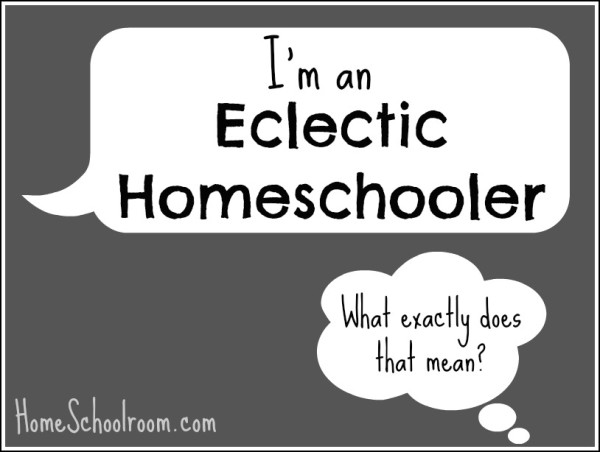
I like neat and tidy things, so sometimes I wish I could label my homeschooling philosophy with one of the catchy phrases that everyone would understand: classical, Charlotte Mason, interest-led, unit study, project-based learning, interest-led, unschooling…
Settling very comfortably into our third year I can’t help but call my style ECLECTIC. Since eclectic means “not following any one system but selecting and using the best elements of all systems,” that term doesn’t really help you understand how I go about educating my children. Yet I can’t avoid summing it up that way since I do, in fact, borrow bits that fit from different philosophies, and change techniques in different seasons and for different subjects.
If you’d like the long-winded description of my version of eclectic homeschooling, then read on for the parts of well-known philosophies that I use in our home schoolroom:
Charlotte Mason
This was the first philosophy that really caught my attention when I was researching homeschooling. I love the use of living books (quality literature written by an author with great interest in the subject) and incorporate her wonderful “extras” like poetry, classical music, fine art, nature study, and handicrafts. I also agree with her focus on habits, being sure the children have free time, and the idea of education as a lifestyle. I love the description I read recently in an article on Sage Parnassus, saying that Miss Mason viewed education as occurring “between a child’s soul and God.” Lovely.
If I had to choose one philosophy this would probably be it, but I am not enough of a purist to feel I can call myself a full “Charlotte Mason” homeschooler because of the areas where I borrow from other philosophies. Oh, and I’m known to frequently re-read a section of a book to my kids (she focused on the habit of attention and only one reading of a text) because someone can’t remember the important points. And sometimes that someone is me. My favorite book so far on this philosophy is A Charlotte Mason Companion by Karen Andreola.
Ruth Beechick
Over this past summer after feeling burnt-out all spring I read The Three R’s and You Can Teach Your Child Successfully by Ruth Beechick. You can read my full review on Curriculum Choice for the details on what I loved about her philosophy. The bottom line: her style is practical, and favors real books and real life over workbooks. Her advice gave me the confidence to avoid packaged curriculum for some subjects.
Whole-Hearted Learning
Educating the Whole-Hearted Child by Clay and Sally Clarkson was another book that provided much-needed inspiration last summer, and they call their philosophy “whole-hearted learning.” Again, their style bears the common theme of whole books versus workbooks. The best pieces I took from this book were the focus on family relationships, the heart of our children in their education, and our overall home environment.
Classical Education
There’s a touch of classical education in my homeschool soup as we study Latin and learn history chronologically, planning to cycle through historical periods more than once. I’ll admit I haven’t read a lot of the classical education literature, probably because I dislike the heavy concentration on memorization in the younger years. Though I like memorizing things that feed the soul, like hymns, Bible verses and poetry, memorizing large amounts of other information sounds like drudgery to me.
Traditional School at Home
We use a full math curriculum with chapters and quizzes (oh, how I love Teaching Textbooks) and I administer standardized tests to my children. My children study the full range of subjects, even if they don’t like a particular topic. We have a fairly structured school day and they are expected to complete all work I assign. We even have desks and a school room! However, I don’t hold strictly to grade levels (though my kids know what number to give people who ask), we shy away from worksheets and fill-in-the blank activities, and I don’t give any other tests or grades to my children.
Unit Studies
When we started homeschooling this was one of my primary techniques. We all loved it and have many fond memories of units we’ve done, but I use it far less now. Within history or science we’ll often spend a period of time on a certain topic, like the human body or Egypt, but I don’t tie in a lot of other subjects so we continue with our other learning each day. Why do I use them less now? My post about planning too much details some of the difficulties. The bottom line: in general I have to be careful not to orchestrate a show for my kids and to let their brains make connections with information. Now I reserve unit studies for when we’re taking a break from regular schoolwork during holidays or vacation weeks.
Interest-Led or Delight-Directed
I have more ideas than I can possibly cover in our school days, but I also work to allow time for my children to follow their interests. Homeschooling provides my children time in the afternoons and Fridays (I plan a four-day school week) to pursue their interests, so in essence part of their education is interest-led. We structure our home, time, and activities to encourage learning all the time. A big piece of this is making sure I provide resources: specialty supplies, books and videos, extracurricular activities and field trips.
Project-Based Learning
I’m intrigued with the idea of project-based learning (PBL), especially as my children are becoming older and more capable of diving into a topic and completing a project truly on their own. I’ve incorporated some PBL for my middle school daughter this year, allowing her to pursue a topic of interest with the expectation that at the end she shows us what she knows through some sort of project. I see this as a great way to work on passion for learning and independence. As such I see it’s true usefulness being in areas where the child has a natural interest, not as a way to cover all subject I deem necessary.
So there is my eclectic philosophy explained in a bit more depth. For some more long-winded explanations about how this style looks in our home, you can check out our 2013-2014 homeschool plans and how we structure our day to fit in all that matters to us.
A Homeschooler’s Christmas
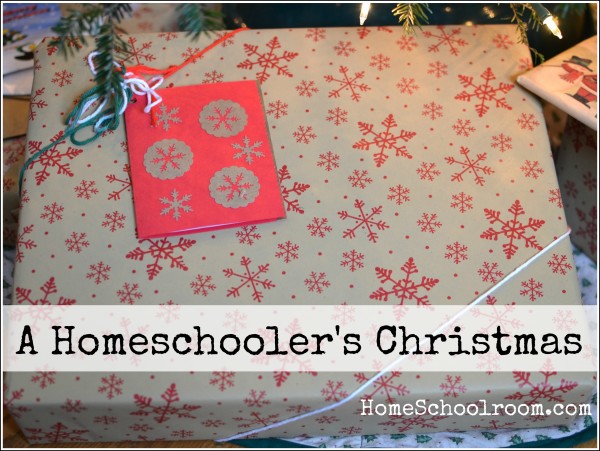
As homeschoolers we often seem to live a life that’s a bit different from much of society. Christmas is no exception to the things that can look different in a homeschooler’s home. Want a peak into our holiday?
Well, some differences are pretty darn easy for our kids to handle, like taking the month of December off from regular schoolwork (even though summer school helps that happen). During the Christmas season we continued reading, music lessons with daily practice, and turned lots of things like Christmas cards and cooking into math and writing lessons. Homeschoolers have an annoying habit of turning everything into a lesson! We cooked and crafted, shopped and wrapped, visited and played, decorated and delighted in the season.
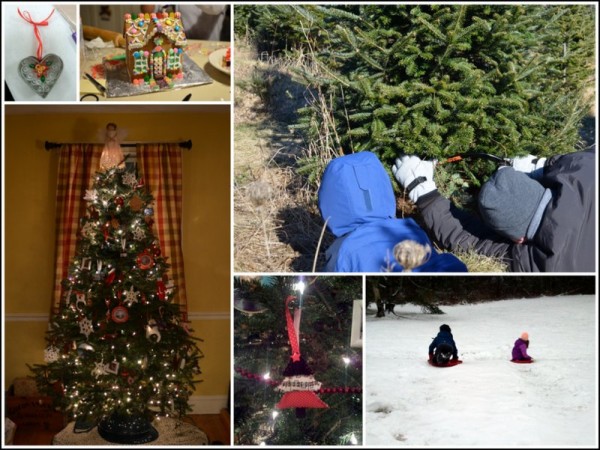
Other differences may make being a homeschooler a little less desirable for my children. I wondered what my children would think of their presents this year. We’ve always tried to keep Christmas spending reasonable, but this year we planned on shrinking the to-buy list even further. Remember, another side effect of homeschooling is that the bulk of my time is spent educating my children versus earning an income. Besides that, I feel our kids have so much already, and our house is full of all our necessary things, our school things, and the things we love.
Our gift choices were carefully made, with my husband and I working hard to find presents that lead to our children’s time being well spent, not frittered away on mindless entertainment. When it came down to it they would each open a few presents, and then I had one box for both of them of things for our schoolwork. Just so you don’t think I’m the meanest mom in the world, I didn’t wrap up their math curriculum or grammar worksheets; these were for extras that they enjoy.
I wanted a creative way to give it to them and prepare them for the contents. While folding laundry a couple rhyming lines popped into my head, and the beginning of a poem was born. I jotted down words over the next couple days. The poem cracked up my kids on Christmas morning, so here it is for your personal enjoyment:
Ode to Homeschooled Children
Homeschooled kids are a sad, sorry bunch,
And not just because they have leftovers for lunch.
Can you imagine a more horrible plight
than living with your teachers day and night?
While regular kids get vacations from school
To spend their days in the sun at the pool,
Watching TV, and playing video games,
Homeschooled kids are still working their brains.
These poor kids just can’t catch a break,
Even on the vacations they take!
When on a family trip they embark
They aren’t headed to an amusement park…
No, historical villages are what’s in store.
And that’s not all–I tell you, there’s more!
For Christmas most kids get the latest in toys,
Gadgets and gizmos and toys that make noise.
But what’s under a homeschooler’s Christmas tree?
Things to build knowledge and spark creativity!
So here’s to the kids educated at home,
To them I dedicate this little poem.
The box was packed with fine arts and science materials:
- Peter and the Wolf from Maestro Classics (a classic story written for Orchestra and Narrator by Sergei Prokofiev)
- Then Sings My Soul (a book that shares the stories behind famous hymns)
- The Kid’s Book of Weather Forecasting (with instructions to build a weather station and make predictions)
- The Hand Book from Klutz (complete with a hand model that should intrigue my two musicians)
The bonus of all this: they enjoyed unwrapping the box, and presenting the items this way reinforces the special gift that education is. Not to mention it will give us some fun new things to add in when we jump back into full time school after a long break. Maybe it will prevent the winter doldrums in the cold, dark days of January and February!
Are you interested in the other gifts that passed our “time well spent” test?
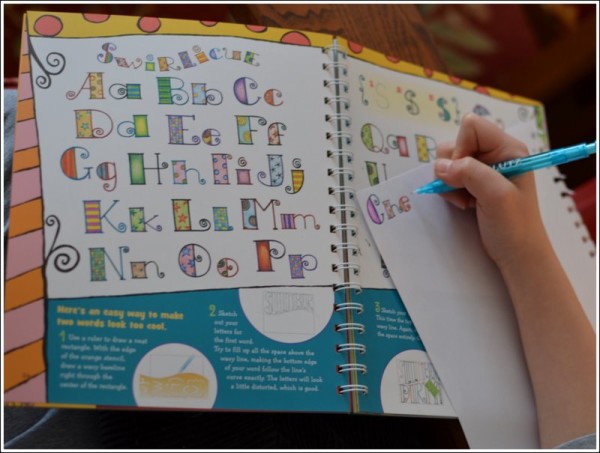
Favorites for my eleven year old daughter:
- Klutz Lettering and Cartooning for Kids books because she enjoys adding artistic flourishes and cartoons to illustrate her notebook pages for school
- Sculpey in gold and silver because she makes accessories for her Victorian dollhouse with this clay that hardens after baking

My eight year old son received several well-loved items.
- He enjoyed a unit we did on owls that included field trip and pellet dissection, so he was delighted to receive a realistic Great Horned Owl stuffed animal and The Book of North American Owls.
- He has an ongoing fascination with military history, so an Eyewitness World War II book provides hours of page-flipping fascination.
- His stocking was filled with scientific gadgets: a prism, a jeweler’s loupe (great nature study tool!), a pocket microscope, and his favorite, an infrared temperature gun. He’s been checking the temperature of EVERYTHING with this tool, and even experimenting with lights on and off, heat from friction, drafty doors, and on and on.
The best part is how our extended family is on the same page at this point! My kids received wonderful educational gifts like a subscription to Cricket magazine, multiple science kits (Smithsonian’s Glow in the Dark Volcano, Potato Chip Science and Pop Bottle Science) and even our very own Lego Robotics kit!
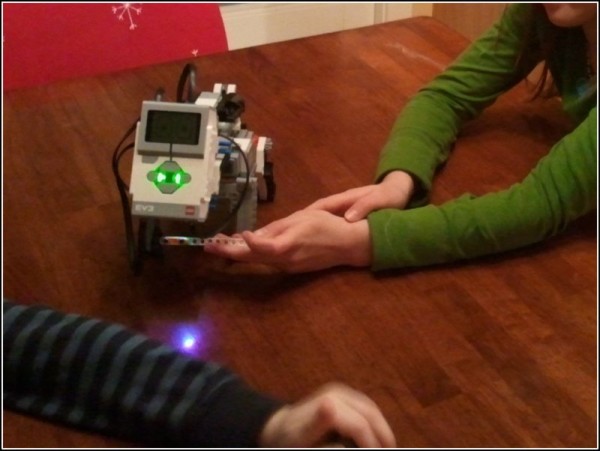
The good news is that my kids both deemed this “the best Christmas ever.”
Now we settle into the post-Christmas winter season as a homeschooling family. We have new things to build our knowledge and spark creativity during cold winter days. Maine has been challenged by the effects of an ice storm all week, and another storm and more frigid temperatures are on the way.
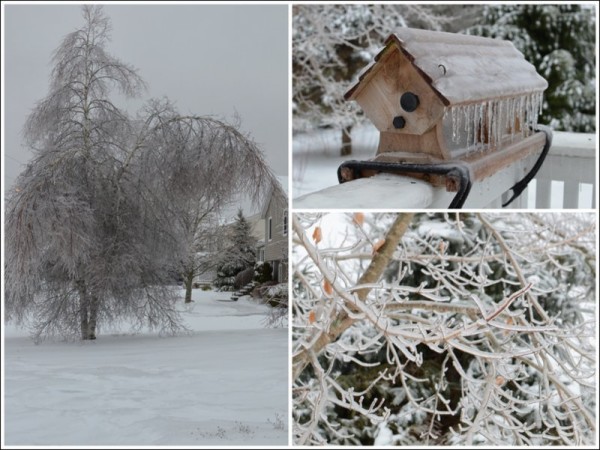
But that’s okay, we’ll be tucked inside by the fire, learning and living together!
Thank you to these wonderful hostesses. Be sure to hop over and see how other homeschoolers spend their Christmas holiday.
Christmas Tree Picture Books and Activities
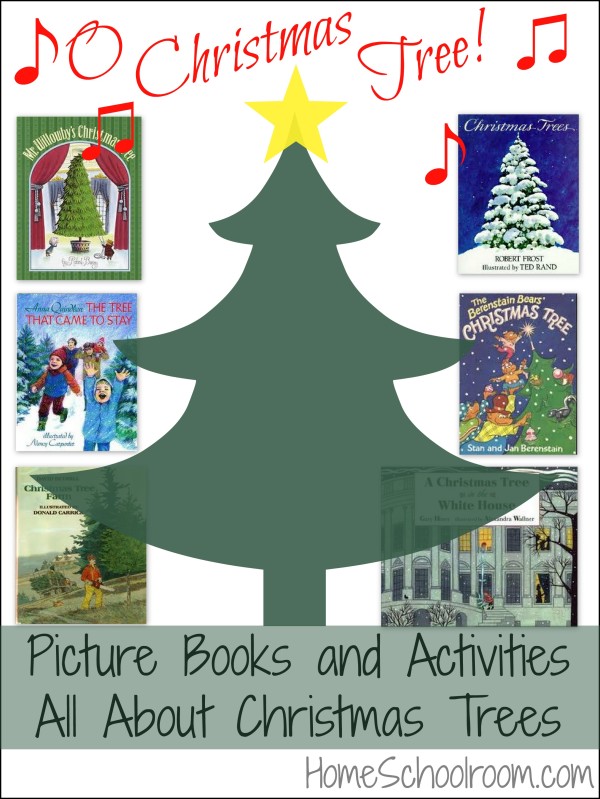
Christmas trees are one of my favorite Christmas decorations. I love sitting in our living room lit only by the twinkling tree lights, reminiscing over Christmases past, recounting the memories in our ornaments, and admiring the pattern of the lights shining through branches onto the ceiling.
We have a collection of beloved Christmas picture books that we revisit like old friends. Just for fun I’m here to share with you our favorite picture books about Christmas trees and activities that pair nicely with the theme–everything from crafts and nature study to poetry and music!
Picture Books About Christmas Trees
Mr. Willowby’s Christmas Tree by Robert Barry: We love this heartwarming story! Wealthy Mr. Willowby has a fine tall tree delivered, but has to cut off the top to fit in his room. The tip of the tree passes down through families (human and animal) to be the center of many celebrations.
Christmas Tree Farm by David Budbill: This is a great living book that tells the story of a man’s work on a Christmas tree farm. Lovely illustrations depict the mountain scenery and the year long job of planting, tending and pruning trees that will grace our living rooms. It’s no longer in print, so check your library or look for another book that tells children about their tree’s life before it came home with you.
The Tree That Came to Stay by Anna Quindlen: This is a sweet story of simple family traditions centered around the tree. I can relate to the sadness of saying goodbye to the tree that shared your Christmas celebrations. In this book they keep a basket of needles from the tree to keep a little part of their tree and the smell of Christmas.
A Christmas Tree in the White House by Gary Hines: This picture book is based on true events during Theodore Roosevelt’s time in the White House. I enjoy stories that let our children learn about past presidents as real people.
The Berenstain Bears’ Christmas Tree by Stan and Jan Berenstain: I am a Berenstain Bears fan, and this story complete with rhyming text doesn’t disappoint. Papa Bear is up to his normal antics as he searches for the perfect Christmas tree, meeting up with misfortunes along the way. As a family that trudges through a tree farm to find our “perfect” tree this story has us laughing, and the tender ending reminds us to think of all God’s creatures during the holiday.
Christmas Trees by Robert Frost and Illustrated by Ted Rand: This poem by Frost was made into a beautifully illustrated picture book. It’s actually alive with the colors of fall on a farm and shows a city man coming to buy Christmas trees from a country farmer. If you know much about Frost you can probably guess that the country life is depicted as preferable.
Christmas Tree Activities

Visit a Christmas Tree farm: If you usually use an artificial tree or buy one from a pre-cut tree lot, try to visit a Christmas tree farm. It’s a treasured tradition in my family to make the trek to the tree farm and wander about the field to choose and cut our own tree. We’ve visited the same tree farm for years. It doesn’t hurt that they offer cider and donuts and a horse-drawn wagon ride!
Make scented sachets from your Christmas tree needles: I love the idea of keeping a little bit of our Christmas tree all year long like in The Tree That Came to Stay. I think we’ll try it this year with scraps of fabric machine or hand sewn into little sachets to tuck into closets and drawers.
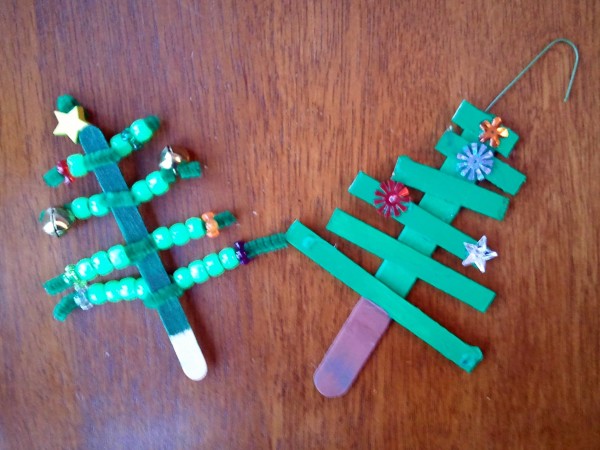
Make an ornament for your tree shaped like…a Christmas Tree! The options are endless so you can find one for any age and crafting ability.
- Pipe Cleaner Christmas Tree: Just paint (or use a marker) to color the craft stick green or brown to make a tree trunk, then wrap green pipe cleaners around your trunk. After that provide an assortment of beads to decorate.
- Craft Stick Christmas Tree: The other tree is also easy and involves gluing craft sticks together to make a tree shape. I recommend using a large craft stick for the trunk and smaller ones for branches. I like using hot glue because it dries quickly, but white glue would be fine if you allow it time to dry. Paint the sticks brown and green and then glue on sequins or buttons or whatever for decorations.
- We’ll be stepping it up this year and sewing this fabric Christmas Tree ornament. I can’t wait to see what mix and match fabrics my kids pick out of our fabric stash!
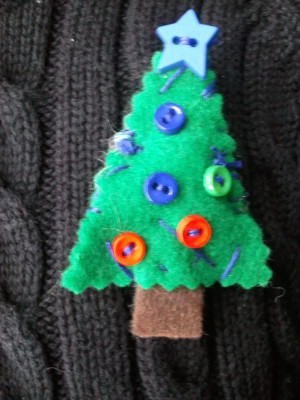
Make a felt Christmas Tree Pin: We started with the idea here, and just added our own touch by decorating it with button ornaments and a star and embroidery floss garland. These were really fun to make, and we just used inexpensive craft felt–though the wool felt would be nice. The photo is one my son made when he was 6. By the way, these make adorable gifts for grandmas or anyone else who would treasure a handmade item from a child they love.
Decorate a tree outside for the birds (and squirrels–we can’t forget Nutty our squirrel friend!): We’ll try some ideas from Wild Birds Unlimited to make some Christmas treats for our feathered and furry friends. On the right hand side of their webpage is a link to download a brochure with recipes.
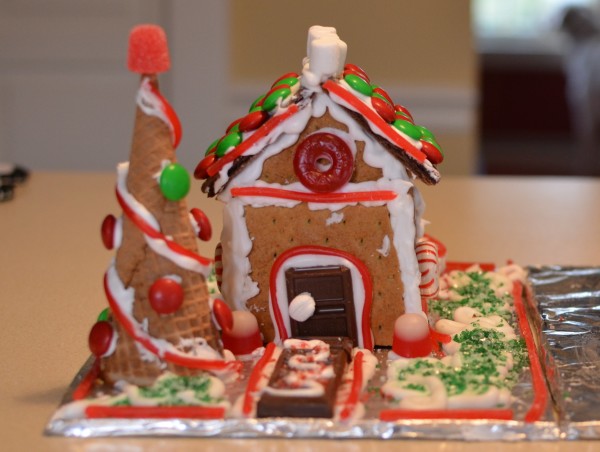
Make edible Christmas trees from sugar cones like these ones from Erica at Confessions of a Homeschooler. I’ve done this with groups of kids at Girl Scouts and kids at my home to add to our gingerbread house decorations.
Incorporate a little nature study: What better time to study trees than when you have a large specimen in the middle of your living room! If you don’t already know the variety you can find out using the Arbor Day website. Here you can see a list of the top ten Christmas tree varieties with links to learn more about them.
Include some music appreciation: How about studying the Christmas Carol “O Christmas Tree” to incorporate a little music? I hadn’t realized how many versions there were until I searched when writing this blog post. You can read a little more about the carol on Wikipedia and listen to whatever version you have in your holiday music at home.
Learn about the history of Christmas Trees: When did people start bringing a tree into their homes and decking it with lights and ornaments? The History Channel offers a lengthy article and many videos discussing the history of the center of our holiday decorating.
If you’re like us and put aside the regular curriculum to savor this special time of year, visit my Pinterest page for more Christmas activities to do with your kids.
You’ll also find more ideas as part of iHomeschool Network’s roundup of winter and Christmas “A Book and a Big Idea” posts!
